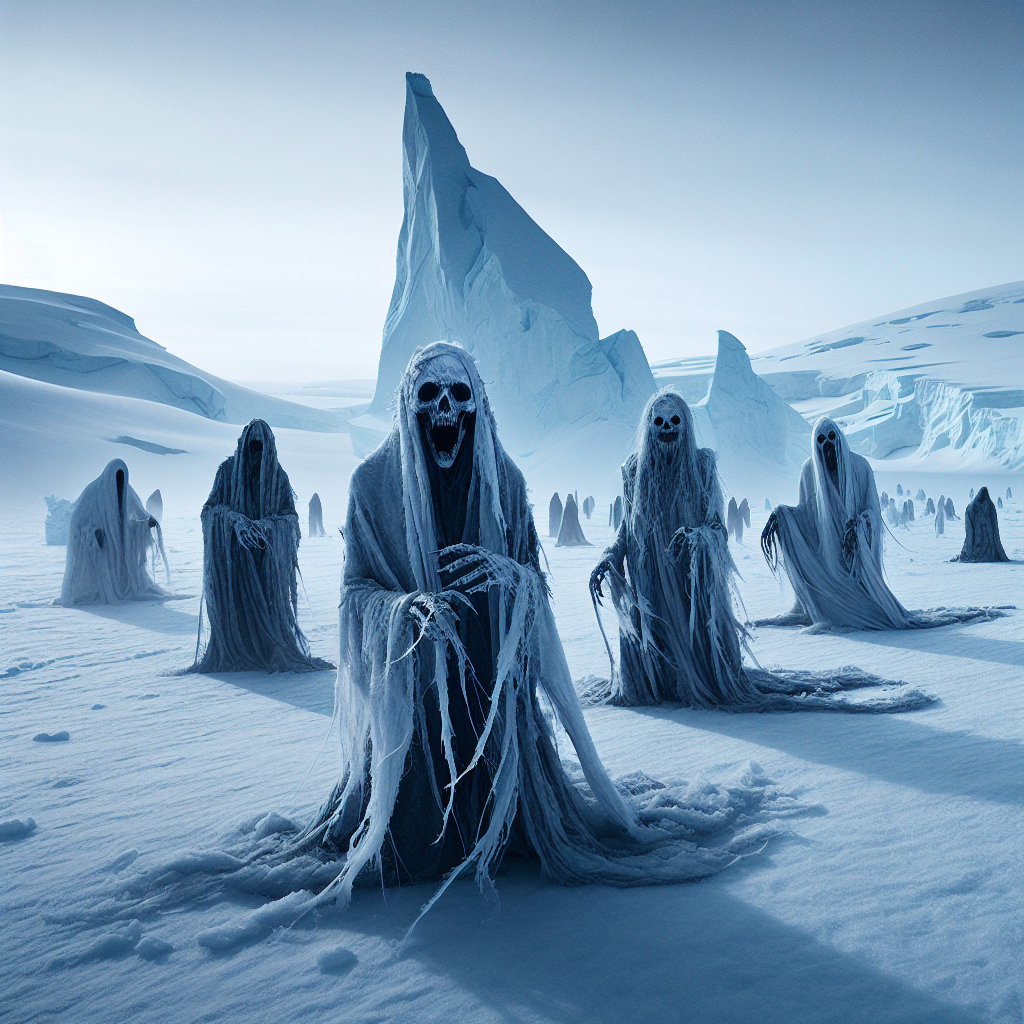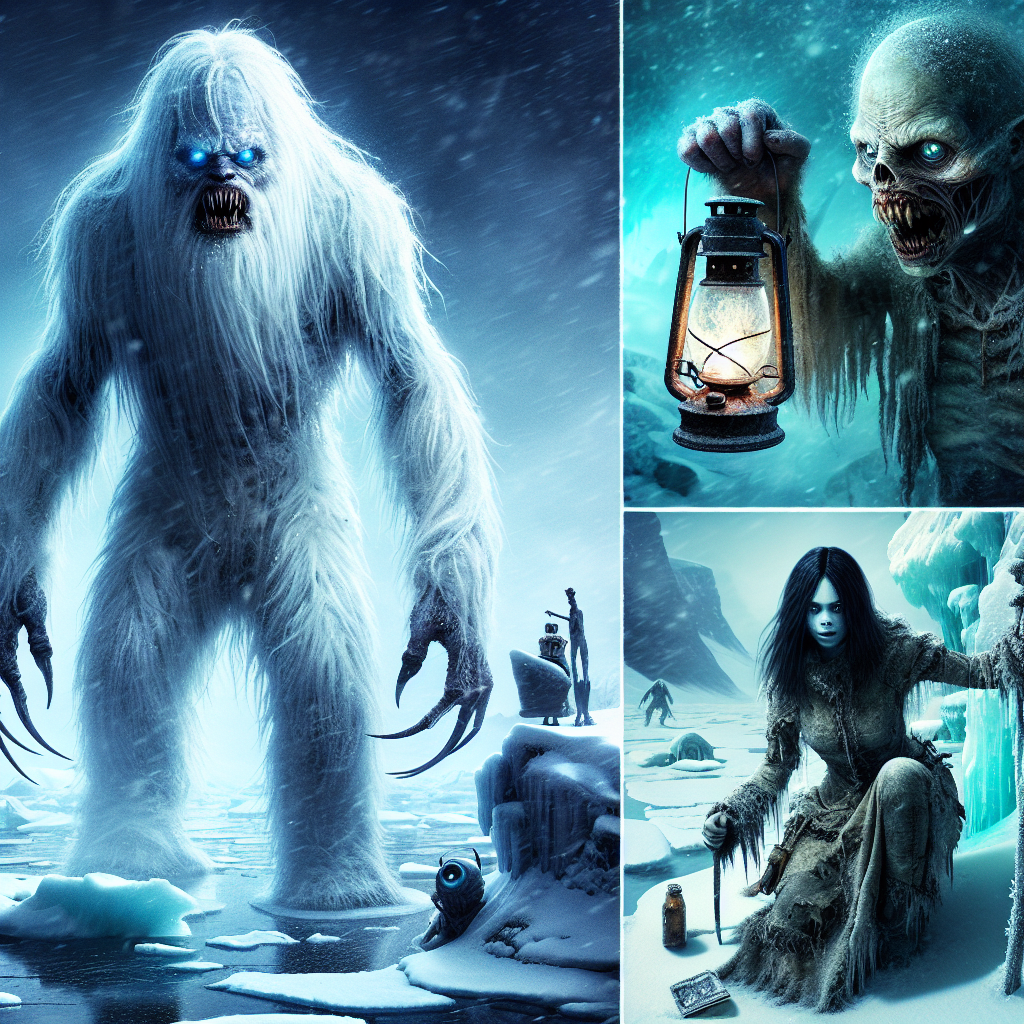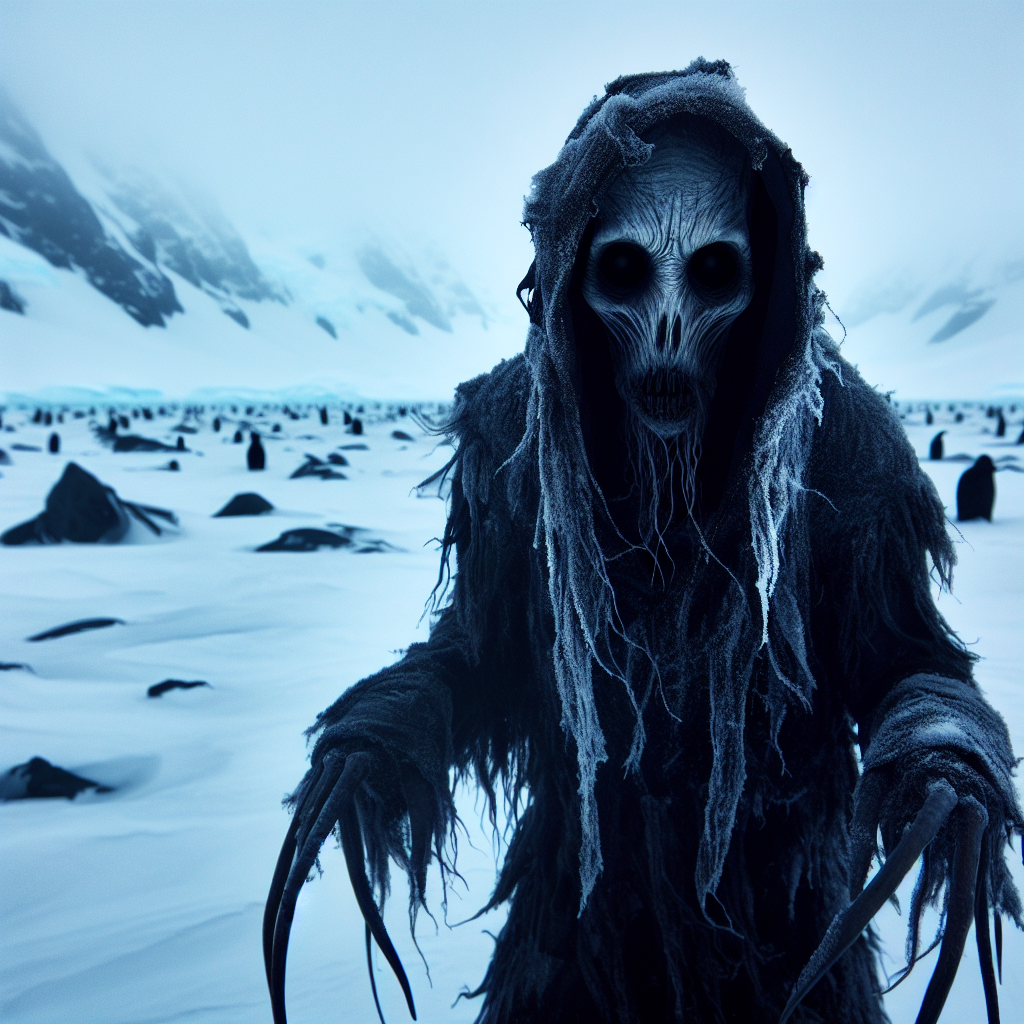The icy and desolate landscapes of Antarctica have long been a breeding ground for chilling tales of horror and madness. In these harsh and unforgiving conditions, where the sun sets for months on end and the isolation is palpable, the human mind can easily unravel. It is in this setting that a myriad of creepy characters have emerged from the depths of Antarctic horror tales – from the malevolent spirits of long-dead explorers to shape-shifting creatures lurking in the shadows. These unsettling figures haunt the frozen landscape, serving as a stark reminder of the dangers that lie beneath the surface of this mysterious continent. Join us as we delve into the twisted and eerie world of Antarctic horror, where the line between reality and nightmare is blurred.
Unveiling the Chilling Characters

The Shapeshifting Shadows
In Antarctic horror tales, the presence of shapeshifting shadows serves as a prominent element that adds to the overall eerie atmosphere of the narratives. These mysterious shadow figures are often described as amorphous entities that lurk in the icy darkness, their forms constantly fluctuating and morphing in unsettling ways.
These shadows possess an uncanny ability to instill fear and uncertainty in the characters they encounter, tapping into deep-seated primal fears of the unknown and the unseen. Their presence is often accompanied by a sense of foreboding, as they seem to embody the very essence of darkness and malevolence.
The shapeshifting nature of these shadows adds a layer of unpredictability to the stories, as they can take on various forms, making it difficult for the characters to discern their true intentions or motives. This ambiguity only serves to heighten the sense of dread and paranoia that permeates the Antarctic setting, keeping both the characters and the readers on edge as they navigate the chilling encounters with these enigmatic entities.
The Whispering Winds
In Antarctic horror tales, the Whispering Winds play a pivotal role in setting the eerie atmosphere and heightening the sense of isolation and fear among the characters. These winds are depicted as carrying haunting voices that seem to beckon and taunt those who dare to venture into the desolate landscapes of the icy continent.
Exploration of eerie voices carried by Antarctic winds
The eerie voices carried by the Whispering Winds are often described as indistinct whispers that seem to echo from the icy expanse itself. They are portrayed as almost sentient, as if the winds themselves are trying to communicate with or lure the characters into the unknown depths of the Antarctic wilderness. The voices are chilling and unsettling, instilling a sense of dread and unease in those who hear them.
Impact on the psychological state of individuals in the tales
The Whispering Winds have a profound impact on the psychological state of the characters in Antarctic horror tales. The constant presence of these haunting voices wears down the mental fortitude of the explorers, leading to paranoia, hallucinations, and a gradual descent into madness. The characters become increasingly obsessed with deciphering the messages carried by the winds, even as they realize the danger that lies in succumbing to their call.
In conclusion, the Whispering Winds serve as a sinister and mysterious element in Antarctic horror tales, weaving a sense of foreboding and terror throughout the narratives as they manipulate the fragile minds of those who dare to listen.

Delving into the Depths of Darkness
The Ice-Covered Entities
In the chilling world of Antarctic horror tales, the ice-covered entities serve as harbingers of doom, lurking beneath the frozen landscape with sinister agendas. These supernatural beings, shrouded in mystery and darkness, embody the malevolent forces that prey on unsuspecting explorers brave enough to venture into the icy unknown.
Examination of Supernatural Beings Hidden Beneath the Icy Surface
Explorers recount encounters with these entities, describing them as ethereal figures cloaked in frost and shadows, their forms distorted by the unforgiving cold of the Antarctic. Some tales speak of creatures resembling distorted human shapes, their features obscured by layers of ice that seem to pulsate with an otherworldly glow.
Their Malevolent Intentions Towards Unsuspecting Explorers
The ice-covered entities are not mere specters of the frozen wasteland; they are malevolent beings driven by a primal urge to instill fear and chaos in the hearts of those who dare to trespass into their domain. Accounts depict these entities as orchestrators of terror, manipulating their icy surroundings to ensnare and torment any who cross their path.
As explorers delve deeper into the depths of darkness that permeate the Antarctic, they come face to face with the chilling reality that the true horrors of the icy expanse are not merely confined to the physical realm but manifest in the form of the ice-covered entities, insidious beings that embody the very essence of fear and despair.
The Haunting Specters
Delving into the Depths of Darkness
- Analysis of ghostly apparitions haunting remote Antarctic locations
In the chilling realm of Antarctic horror tales, ghostly apparitions play a significant role in instilling fear and unease within the narrative. These spectral entities are often portrayed as remnants of tragic events that have unfolded in the icy wilderness, lingering on in a state of perpetual torment. Whether they manifest as shadowy figures wandering the desolate landscapes or as disembodied voices echoing through the icy winds, these haunting specters serve to heighten the atmosphere of dread and isolation that permeates Antarctic horror stories.
- Their connection to tragic events from the past

The haunting specters in Antarctic horror tales are frequently intertwined with the dark history of the continent, drawing upon real or imagined tragedies to fuel their eerie presence. These ghostly entities are often depicted as the restless souls of explorers who met untimely demises in the harsh and unforgiving environment of Antarctica. Whether they met their end through accidents, starvation, or madness, these spirits are bound to the icy landscape, condemned to relive their final moments in a perpetual state of anguish. Their presence serves as a grim reminder of the dangers that lurk beneath the frozen surface of the Antarctic wilderness, adding a layer of psychological terror to the already foreboding setting.
Unmasking the Malevolent Forces
The Ancient Eldritch Beings
Unmasking the Malevolent Forces
In Antarctic horror tales, the presence of ancient eldritch beings serves as a central element that instills fear and sets the eerie tone of the narratives. These entities, often depicted as otherworldly and incomprehensible, add a layer of cosmic horror to the stories, leaving characters and readers alike in a state of unease and dread.
- Uncovering ancient entities awakened from their slumber in Antarctic narratives
Within the frozen landscapes of Antarctica, these ancient eldritch beings are frequently portrayed as dormant entities that have been disturbed or awakened by human exploration or intervention. Their emergence from slumber triggers a series of unsettling events, signaling a shift in the balance of power and a descent into chaos and madness.
- Their role in influencing the actions of characters in the stories
The ancient eldritch beings wield a profound influence on the characters within the Antarctic horror tales. Their malevolent presence exerts a corrupting influence, driving individuals to madness, obsession, or self-destruction. Characters often find themselves ensnared in a web of cosmic manipulation, their fates intertwined with the incomprehensible agendas of these entities. As the narrative unfolds, the true extent of the beings’ power and malevolence becomes increasingly apparent, heightening the sense of foreboding and terror that permeates the stories.
The Possessed Explorers
In Antarctic horror tales, the presence of possessed explorers adds a chilling layer of terror to the narratives, showcasing the malevolent forces at play in the icy wilderness. These characters, once ordinary individuals seeking adventure in the unforgiving landscape, become vessels for unknown and sinister entities, transforming them into harbingers of doom.
-
Individuals Possessed by Unknown Forces: The possessed explorers in these tales are depicted as undergoing a gradual and unsettling transformation, both physically and mentally. Their once rational and human characteristics are slowly overtaken by something otherworldly and malignant, leading to a stark shift in behavior and appearance.
-
Terrifying Transformations: As these explorers succumb to the malevolent forces lurking in the Antarctic expanse, their transformations become increasingly grotesque and horrifying. Their eyes may glint with an unnatural light, their voices may echo with a sinister undertone, and their movements may become erratic and inhuman, instilling fear in those around them.
-
Adding a Terrifying Element to the Horror Tales: The presence of possessed explorers serves to intensify the sense of dread and unease in Antarctic horror stories. Their unpredictable actions, fueled by otherworldly influences, create a sense of impending danger and paranoia among the remaining characters, heightening the suspense and driving the narrative towards a terrifying climax.
Confronting the Unknown
The Unseen Entities
Confronting the Unknown
- In Antarctic horror tales, the unseen entities play a crucial role in intensifying the sense of fear and suspense within the narratives.
- These entities are often described as lurking just beyond the edge of human perception, heightening the mystery and otherworldly atmosphere of the Antarctic setting.
- Authors use these unseen entities to instill a deep sense of dread in the characters and readers alike, as the unknown and unexplained aspects of these beings create a feeling of unease and tension.
- The presence of these entities serves to emphasize the isolation and vulnerability of the characters in the harsh Antarctic environment, where they are not only battling the elements but also facing unseen threats that defy comprehension.
- By keeping these entities shrouded in mystery and ambiguity, the stories leave room for the imagination to run wild, allowing for a more profound impact on the psychological horror experienced by the characters and the audience.
The Psychological Terrors
-
Isolation and Claustrophobia: One of the key psychological terrors faced by characters in Antarctic horror tales is the overwhelming sense of isolation. Surrounded by endless snow and ice, with no escape routes, characters experience a deep-seated fear of being trapped in a desolate, unforgiving landscape. The claustrophobia induced by the vast, icy expanse can lead to paranoia and a distorted perception of reality.
-
Hallucinations and Delusions: As characters grapple with the extreme conditions of the Antarctic environment, their minds can play tricks on them. Hallucinations of ghostly figures in the snowstorms, whispers in the howling winds, or shadows lurking in the darkness become all too real. Delusions take hold, blurring the line between what is imagined and what is actually happening, heightening the psychological horror experienced by the characters.
-
Survival Instincts vs. Moral Decay: Another aspect of psychological terror in Antarctic horror tales is the internal conflict between survival instincts and moral decay. When faced with the harsh realities of the icy wilderness, characters are forced to make difficult choices that test their humanity. The struggle to maintain a sense of morality in the face of extreme circumstances can lead to a gradual erosion of sanity, as characters grapple with the dark impulses that emerge in the fight for survival.
Embracing the Fear
In Antarctic horror tales, the element of fear is not merely a fleeting sensation but a deeply ingrained emotion that seeps into every aspect of the narrative. The setting of the icy, desolate Antarctic landscape sets the stage for a chilling atmosphere where characters are not only battling the harsh environment but also confronting sinister forces beyond their comprehension. Here, the creepy characters play a pivotal role in amplifying this fear, invoking a sense of unease and dread that lingers long after the story has ended.
The Power of Imagination
- Antarctic horror tales leverage the power of imagination to create creepy characters that tap into primal fears and insecurities.
- These entities often embody the unknown and the otherworldly, pushing the boundaries of what is familiar and plunging characters into a realm of uncertainty and terror.
- By leaving aspects of these characters shrouded in mystery, storytellers invite audiences to fill in the gaps with their own fears and anxieties, making the horror all the more personal and unsettling.
Evoking Dread
- Creepy characters in Antarctic horror tales are masterfully crafted to evoke a sense of dread and foreboding.
- Their eerie presence looms over the narrative, casting a shadow of fear that permeates every interaction and decision made by the protagonists.
- Through subtle hints and gradual reveals, these characters instill a creeping sense of horror that intensifies as the story unfolds, keeping audiences on edge and captivated by the unfolding terror.
Psychological Impact
- The creepy characters in Antarctic horror tales often serve as mirrors, reflecting the deepest fears and vulnerabilities of the protagonists.
- By embodying aspects of the characters’ own psyche or manifesting their inner demons, these entities become not just external threats but manifestations of internal turmoil and conflict.
- This psychological depth adds layers of complexity to the horror, blurring the lines between reality and nightmare, and leaving audiences questioning the nature of fear itself.
In essence, embracing the fear in Antarctic horror tales means immersing oneself in a world where the line between the known and the unknown is blurred, and where creepy characters lurk in the shadows, waiting to unleash their terrifying presence on unsuspecting souls.
FAQs: Creepy Characters in Antarctic Horror Tales
What are some common creepy characters found in Antarctic horror tales?
In Antarctic horror tales, common creepy characters include polar expedition explorers who succumb to madness or supernatural forces, eerie human-like creatures that lurk in the snowy landscapes, and malevolent spirits or entities that haunt the desolate ice-covered terrain. These characters often embody themes of isolation, fear, and the unknown, adding layers of suspense and terror to the Antarctic setting.
Are there any specific legends or myths that inspire creepy characters in Antarctic horror tales?
One commonly cited source of inspiration for creepy characters in Antarctic horror tales is the legend of the Lost Franklin Expedition, a real-life polar exploration mission that ended in tragedy. The mysterious disappearance of the crew and rumors of cannibalism have fueled speculation and lore surrounding the expedition, making it a popular source of inspiration for eerie characters in Antarctic horror stories. Additionally, the harsh and unforgiving environment of Antarctica itself serves as a backdrop for creating chilling and otherworldly characters in these tales.
How do creepy characters contribute to the overall atmosphere and tension in Antarctic horror tales?
Creepy characters play a crucial role in shaping the atmosphere and tension in Antarctic horror tales by invoking fear, suspense, and a sense of unease in readers. Their presence adds a layer of mystery and danger to the already haunting setting of Antarctica, heightening the stakes and keeping readers on the edge of their seats. Whether they come in the form of deranged explorers or supernatural beings, creepy characters bring a chilling and unsettling element to these tales, making them all the more captivating and terrifying for audiences.
